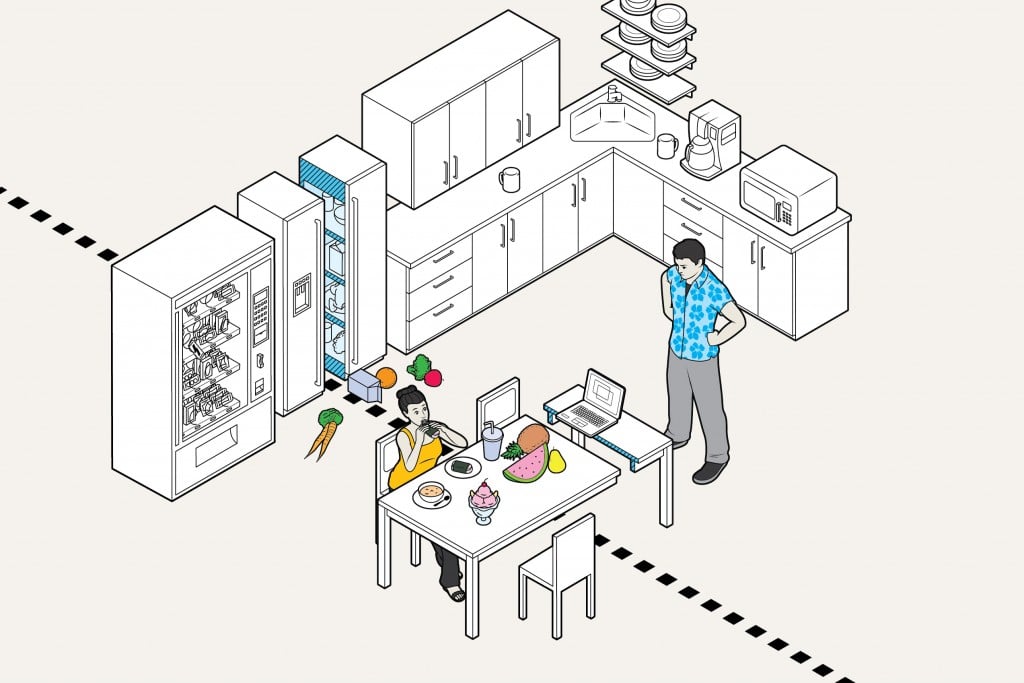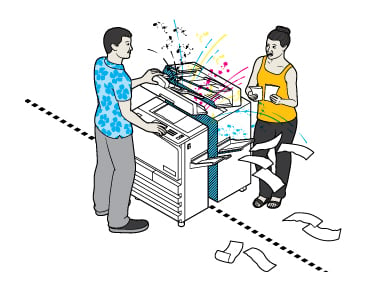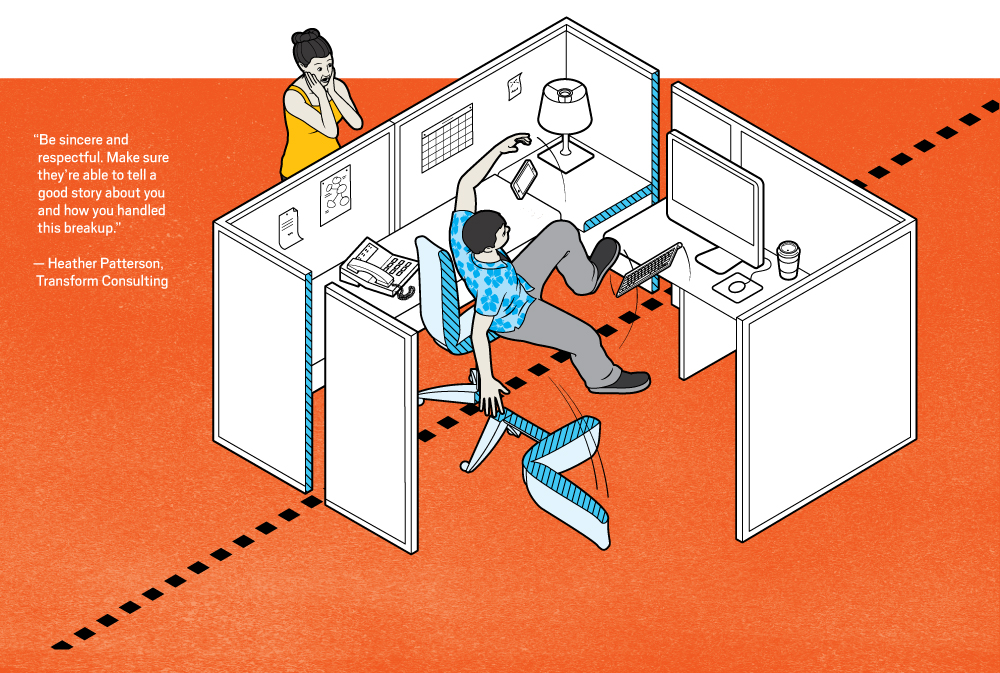Breaking Up is Hard to Do (In Love & Business)

Charletta Wilson was 18 months into a lucrative consulting contract when she realized the firm that had hired her was engaged in unethical accounting practices. She didn’t like it, but wasn’t sure what to do. Could she really walk away from such an important client?
“You go through a rationalization process,” says Wilson, of Capeesh Consulting, based in Hawaii. “Ending a relationship is not easy, and when you take into consideration your own livelihood, you question it.”
In the end, Wilson decided she had to break things off. But she knew how she broke it off needed to be handled with care.
“There was some fear involved, because it was a really big operation,” she says. “I was privy to information that could have been detrimental to many lives, so there was a fear about what the consequences might be, and how this would follow me in the future.”
Whether parting ways with a troublesome client, letting go of a contractor or splitting from a partner, ending an important business relationship can feel as stressful and difficult as a “real” breakup. The blending of close business relationships into personal friendships can make a split even more painful. Compounding the possibility of hurt feelings are fears that a nasty separation could mean lost income, lawsuits and bad blood that could harm you and your business far into the future.
“Where I’ve dealt with this problem the most is with law firms,” says Kim Payton, an organizational psychologist and consultant based on Oahu. “When a law firm splits, the clients can get very skittish and wonder if something bad is happening. It can be very threatening to the reputation of the firm.”
So what’s the secret to ending a business relationship well? You create a solid foundation by communicating discontent early and making expectations clear, experts say. And when it’s time to end things, keep conversations respectful and professional, avoid emotional reactions, and be careful about what you say in public. That gives everyone a chance to walk away with their pride and reputations intact.
“You want people to go away saying good things about each other,” Payton says. “Whether it’s an employee separating from a business, or a partnership splitting up, if everybody says good things about everybody else, there’s very little damage.”
< You’ve Lost that Lovin’ Feeling >
The cause of many breakups, especially partnerships, often comes down to fundamental differences in values. “Usually people are so busy working that they don’t have time to talk about that kind of stuff,” Payton says. “They end up drifting apart and focusing on their own reasons for doing things.”
Starting a thoughtful conversation about the company’s purpose and mission can shift the focus from day-to-day frustrations to a calm assessment of whether everybody’s on the same page. “Sometimes you find there’s a bifurcated picture,” he says. “There’s a small group of people who don’t support the larger cultural preference, and they split off and do their own thing.”
As in marriages, sometimes business associates simply grow apart. “It doesn’t have to be nasty, it can just be a change of direction or goals,” says Honolulu business consultant Heather Patterson of Transform Consulting.
One of her clients was a business owner who had a longstanding relationship with a Mainland-based bookkeeper and accounting service. The relationship had worked well when her client was just getting started, but after seven years he realized he was no longer getting what he needed. “It was a classic case of evolution and just needing more,” she says.
Sometimes the reason for a split is more egregious. If a client is mistreating your employees, it may be necessary to end the relationship – even if it’s lucrative, Patterson says. The abuse could include inappropriate emails or text messages; physical aggression; demeaning comments, especially over protected characteristics like race, gender or sexual orientation; or sexual harassment, like asking for dates, lingering inappropriately or stalking. When that happens, the business owner must step in immediately to discuss appropriate conduct and set clear boundaries, she says. Be sure to document any cases of abuse and, if the problem continues, it may be necessary to fire the client.
“It’s the employer’s responsibility to protect employees,” she says. “The company has to be willing to confront that regardless of how much money the client brings in.”
You can set yourself up for success by establishing clear expectations from the beginning of the relationship, and follow up with good communication as things develop, says Danelia Newman of Newman Consulting Services, based in Kakaako. “It’s important to have that open relationship,” she says. “It’s just like a marriage. You’ve got to talk things out.”
If concerns arise, bring them up as early as possible, by giving feedback and making your needs clear, Patterson says. That gives the other person a chance to address the problem before it gets bigger. If the issues aren’t resolved and it ultimately becomes necessary to part ways, it will also be less of a surprise to the other person. “When you can direct it back to that vision or those deliverables, it becomes far less personal,” she says.
 Letting a problem fester, and then blowing up at the other person, is all too common, Payton says. “If people haven’t talked about the issue, and it’s gotten to the point where emotions are running really high and there’s a lot at stake, you can figure things are going to go bad.”
Letting a problem fester, and then blowing up at the other person, is all too common, Payton says. “If people haven’t talked about the issue, and it’s gotten to the point where emotions are running really high and there’s a lot at stake, you can figure things are going to go bad.”
Handling the breakup of a partnership is especially delicate, because the emotions and the financial stakes are often both higher, Newman says. “It can be just like a divorce,” she says. “Stress, anger, hostility, and that’s not a positive thing for anybody, certainly not for the business.”
It’s especially important to talk to an attorney about how to protect your business during the breakup of a partnership, she says.
“You need professional help,” Newman says. “If you’re anticipating there will be a lot of hostility, you need to prepare ahead of time, not at the moment when this all blows up.”
Manage your emotions and take time to respond calmly, Patterson says.
“I really cannot stress enough the power of being respectful,” she says. “There’s a seesaw with emotion and logic, and whether it’s your partner, or a vendor, or a contractor, they might do something that really frustrates you or makes you sad or angry, but before you make any quick decisions, get the facts and the data and really think about it before rushing into a breakup.”
Priming the other person for a difficult conversation can help the meeting go more smoothly, says Daniel Post Senning, an etiquette expert with the Emily Post Institute in Burlington, Vermont, and co-host of the Awesome Etiquette Podcast. If your relationship is normally casual or most interactions are handled over email, simply letting them know that you want to have a private, in-person conversation in your office may be enough of an indicator that something’s up, he says. If not, you can always tell them when you schedule the meeting that you have something serious to discuss. “It’s a way to give them time to mentally prepare,” Post Senning says.
Consider your timing when ending a relationship, and give the other person an appropriate amount of notice. A contractor or freelancer may have other clients and be able to transition out of the relationship quickly, while some vendors may need breakdown time, Patterson says.
Think about your own company’s needs as well. If you haven’t yet found a replacement, or you don’t know how much time the new contractor will need to get started, you may be left with a gap. “You might be having this conversation prematurely if you’re not careful,” Patterson says.
Of course, be sure to check any relevant contracts before having the conversation, Patterson says. “If you’re not clear on it, talk to counsel or the person that originally engaged in the contract, because it may not have been you.”
< We Are Never Ever Getting Back Together >
Choosing the right time and place to communicate the difficult news is important. Plan on an in-person conversation “Letting someone go over email is a great way to add insult to injury,” Post Senning says.
“Set up a meeting with the other person face to face, in an office environment,” Newman says. Avoid having a difficult talk over lunch or in a public setting, in case the conversation gets heated.
Also make sure you set aside enough time for the other person to respond, Post Senning says. “The meeting isn’t going to be five minutes,” he says. “Be prepared to answer questions and talk about the decision you’ve made.”
Especially with vendors, “if they’re being replaced with a competitor, they’re going to want to know which one and why,” says Patterson. “I think that’s up to the decision-maker how much to reveal.”
If the other person works remotely or an in-person meeting is impossible, a phone call is the next best alternative.
Also consider using Skype or another video calling service, so the other person can pick up the message you’re sending with eye contact and body language. Above all, “Be sincere and respectful,” says Patterson. “Make sure they’re able to tell a good story about you and how you handled this breakup.”
Of course, “Don’t send somebody else in your place,” Newman says. “It can be uncomfortable, but you need to be the one to do it because you’re the one who had this relationship with the other person over the years.”
When it’s time to break the news, be calm and respectful, but straightforward. Tap-dancing around the issue or being wishy-washy can cause confusion, Post Senning says. “It’s easier to hear if someone’s clear, so the message isn’t ambiguous.”
At the same time, be tactful. Avoid a Trumpian “you’re fired!” Post Senning says. “It’s abrupt,” he says. “It’s almost attacking language, doesn’t give any information, doesn’t acknowledge or take into account someone else’s feelings or perspective.”
Stay calm and don’t let yourself get emotional, Newman says. “If the other person becomes hostile, do not react. Be professional at all times,” she says. “Say, ‘I’m sorry this didn’t turn out as expected, but I really learned a lot through this experience and I’m grateful to have worked with you. Be humble and appreciative. At no time become condescending or accusatory, no matter how the other person reacts.”
Instead of turning on the other person and focusing on what they did wrong, use “I statements,” and talk about what you’ve observed, what you’ve asked for, and what you need. Focus on including the other person. “You can say, ‘Let’s talk about how we can unravel this in a way that works for both of us,’ ” Patterson says.
Sometimes it may take more than one conversation. “If you’re going to give them feedback, maybe give them time to cool off from the breakup, and come back later to have a conversation about why things weren’t working,” Patterson says. “It really depends on if the person is ready to hear what you’re going to say.”
Conversations can go south when people feel pressured and “backed into a corner,” says Payton.
“Part of what puts people into that place is rushing. Why do we have to do it by next week?” he says. “Deliberation takes time.”
Give the other person a chance to reflect on what you’ve said, cool off and consider their options. “People don’t process this kind of stuff in one meeting,” he says. “They need to think about it, talk to their spouse, check with their financial advisor, and do a whole lot of other stuff – including letting their ego blow off steam.”
Sometimes contracts end not because of a problem with the consultant, but because the firm loses a big client or a project comes to an end. If it’s truly a “no fault” divorce, say so, giving as much information as is appropriate, Post Senning says. “If things went well, you can thank someone for their time, tell them you appreciate the effort they put in, the quality of their work, whatever attributes they brought to your organization,” he says. “Those are all ways to let someone know they made a valuable contribution.”
Once you’ve talked and decided it’s time to split, finish by trying to agree on a few talking points about the reason for the breakup. “It’s really important to come up with a common story that everybody’s willing to tell – a story that doesn’t harm any of the parties involved,” Payton says. “It saves the ego, it saves the reputation, and it gives people something to go to when somebody asks them what happened.”
Even if a breakup goes well, taking the extra step of sending a follow-up note to the other person can leave a strong positive impression and foster lasting goodwill, Post Senning says. The content can be brief, as long as it’s sincere: simply thank the other person for their service, or tell them it was a pleasure working with them and you hope your paths cross again in the future. Email is fine, but a handwritten note can make a big impact. “You might be the only former client that sent a consultant a little thank-you note, and all of a sudden they might be referring people to you in the future,” Post Senning says. “It’s a real opportunity.”
In some cases, it might also be appropriate to follow up with more information about what happens next, a checklist of what must be done, or a timeline for wrapping things up, Patterson says.
As much as you may be dreading an uncomfortable conversation with a client or consultant, don’t try to avoid it by simply fading away. Post Senning points to the concept of “ghosting,” a phenomenon most often described in the context of millennials’ dating, in which one person simply stops responding to the other person’s calls or texts, rather than taking the time to officially break up. “Don’t ghost on your business partners,” Post Senning says. “Just like in your personal life you don’t want to disappear on someone and leave them wondering what happened, you don’t want to disappear on your business relationships either.”

Once Wilson decided she needed to end her relationship with her unethical client, she moved forward carefully and deliberately. “It was a process. It didn’t happen immediately,” she says. “My exit strategy took a couple of months.”
She began limiting her contact with the client, keeping communications professional but succinct. Once she was ready, she approached the client and let them know she wanted to withdraw from the contract, showing how the change would also make sense for them economically. “I took the emphasis off what was bothering me, because I didn’t think they were going to change,” she says.
At first the client was disappointed. “Actually, there was a counter. They offered me more money,” she says. When she stood firm, the client accepted her decision, and they began a transition process that included handing over her work materials and other proprietary information to the client.
In the end, Wilson says, disentangling herself from the relationship was stressful and emotionally difficult, but she’s glad she didn’t back down. “At the end of the day, it was a success story, because I know I did the right thing.
< Should I Stay or Should I Go? >
➸ You might feel a business relationship isn’t working, but how do you know if it’s really time to pull the plug? Payton says many people get stuck in indecision or avoidance.
“It’s worse than ambivalent, there’s a huge amount of denial,” he says. “‘If I can just pretend this is ok, then it won’t be bad.’ People are so busy just staying afloat, they tend to repress a lot of this stuff. If we don’t like it, we don’t look at it.”
If you’re unsure if a breakup is the right thing, take time to reflect deeply on the situation, Newman says. “No. 1 is to really look inside of you,” she says. “Basically all of us know deep down what is the right move and what is not the right move. Most of us just don’t allow ourselves to get to that place.”
Some people even find that meditation can be an effective way to clear your mind, set aside emotions, and get a calmer, deeper perspective. “In all honesty, if you truly get your emotions out of the picture, you recognize when things aren’t working,” she says. “But most of us don’t do that. We become emotional about it and then react, instead of staying calm.”
Once you accept there’s a problem, try addressing it before you decide to end things. Patterson says she had a local client who couldn’t figure out why the relationship with his Mainland accounting firm was no longer working. “I said, ‘Just like if this was an employee, give them an opportunity to meet your needs. Do they know that you want this?’ ” she says. “Really and truly, he hadn’t asked. People can’t deliver if you’re not asking for what you need.”
But if you’ve given the other party a chance to deliver, and they’re still not able to to so, it’s time to consider ending the relationship. “If you’re a business, and you’re spending money on a product or service and you’re not getting what you need out of it, it’s sort of questionable as to why you would continue to buy it.”






